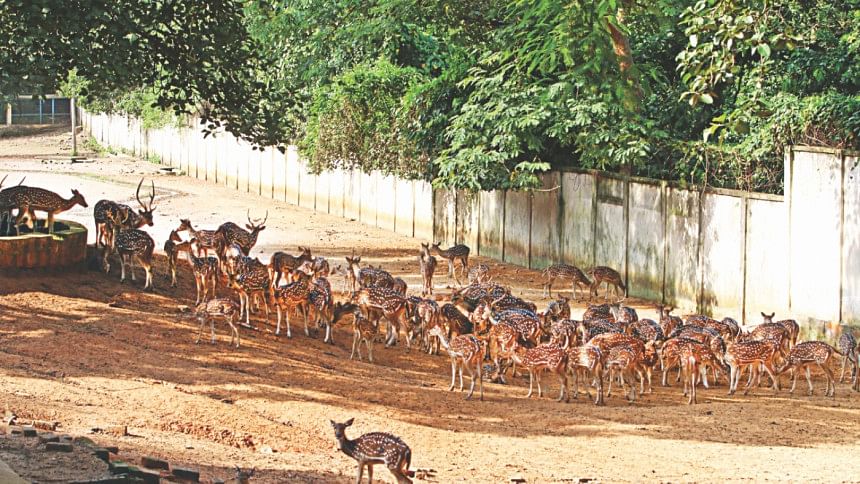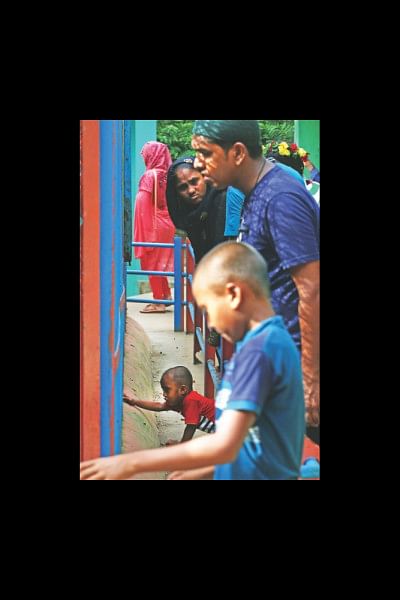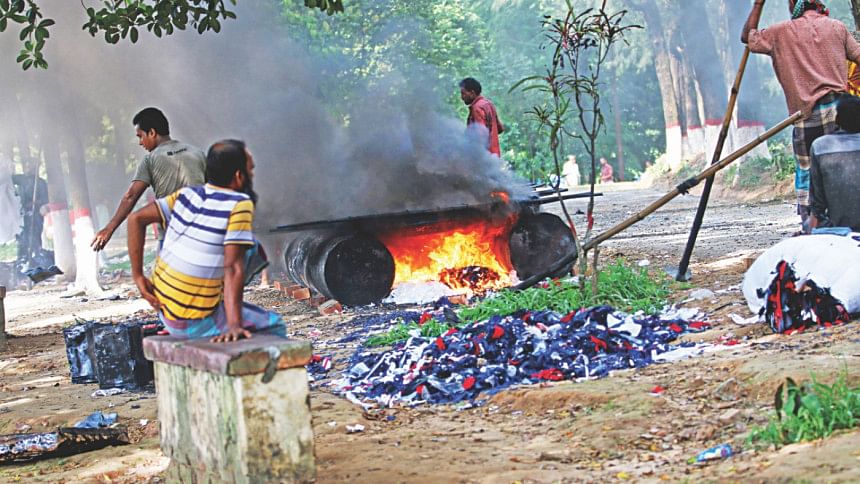MY ZOO and other fatalities

It doesn't matter how beautiful the cage is. It's still a prison.—Natasha Ngan, Girls of Paper and Fire
And here, smack in the middle of one of the busiest areas of the even more maddeningly crowded Dhaka, are the cages of Bangladesh National Zoo. Here, sprawled over 186.33 acres of land, are nearly 2,773 species of birds, mammals, reptiles, amphibians and fish. It is considered one of the top choices for an entertaining day out. But something is not quite right with the zoo. At the centre of widespread controversy and allegations of animal abuse in the wake of Heera the lion's death, the passage of animal welfare bill, and talks around town about modernisation of the zoo for years, members of Star Weekend—Shah Tazrian Ashrafi, Kazi Tahsin Agaz Apurbo and myself—decided to pay a visit to the zoo over four consecutive days. We sought to understand what was happening there, what facilities the animals were getting and what they weren't, how visitors treated them and the possibility of a better future.
What did we find at the zoo?
Everything is crowded. Sounds of vuvuzelas send a shrill through the motionless wind. All of that is topped with vendors screaming out their wares, from chanachur to cotton candy. This is prime carnival location, except just mere feet away is a very humble enclosure full of spotted deer. They are countless in number compared to the space. Currently, there are 250 spotted deer in three cages.
The estate officer of the zoo Ashim Kumar Das says when the master plan is implemented the number would be brought down to a total of thirty in three enclosures.
Then why were they so many?
"Only a few deer in an enclosure is not as beautiful to watch as a larger number is. People enjoy it and that is why we have so many of them in one enclosure, even though for an ideal environment, there should be way less. The number will come down obviously after modernisation of the zoo," adds Das.
The large number of deer also serves another purpose. The zoo authorities often sell these deer to their clients for Tk 70,000 each. "Just last February, the authorities sold a deer to a private client," he says. However, sales are few and far in between.

The afternoon I visited, the zoo was teeming with people, crowding and shouting around the deer enclosure, severely confusing and agitating the animals. In fact, a study by ecologist Justin Suraci of the University of California at Santa Cruz found that even the gentlest of human speech can make wild animals—even top predators—unnerved and watchful, in ways that shake entire food webs. Noise pollution apart, the entire compound was arid and dusty. Each step by a deer, and a storm of dust flew up. The sun blazed on, relentless and hot, but these deer had not enough shade, nor enough tree-cover to go stand under and cool off. The water body within the enclosure was not nearly enough for the number of animals there.
Asked whether there is any option for the deer to graze in the compound, a zoo official pipes in to say, "Did you see any grass on the compound for them to graze? The moment we plant grass, they eat it down to the roots. But each deer is provided with food according to their nutrition needs after consulting with the veterinarian and nutritionist stationed at the zoo."
In the wild, I have seen deer run through the grasslands of Sundarbans, much less in number than the ones here in this tiny enclosure, grazing on low-hanging Sundari trees. They take shelter under the shadow of the dense canopy of the forest during the rains. Here, the moment a storm came bringing relief from the heat, it soaked everything in sight and the deer all stood stunned and in the process got dripping wet.
There were small congested sheds but they were inadequate for the deer.

As you walk further into the zoo premises, it continues to get more and more depressing. Solid waste pollution is everywhere. When questioned on the matter, the authorities said, they do not have nearly enough manpower to fully ensure cleanliness.
"We are supposed to have 250 employees, but over the years due to old age and retirement, we now only have 150, which is not adequate, given the number of visitors," the deputy curator says.
They claim that they regularly clean the premises before 9am but that visitors litter the area immediately afterward. However, I also visited the zoo on a Sunday, which is their weekly holiday, yet I found a discarded generator, a pile of trash and leaf litter burning right inside the premises at half past three in the afternoon.
Pollution takes on many forms here. Not only is there no dearth of solid waste, the zoo has it all—noise pollution, air pollution and plastic pollution—to name a few.
Just last Monday, our photojournalist visiting the zoo found workers burning tar, billowing out ashy, toxic smoke in huge waves engulfing large swathes of the sky and nearby cages housing zebras, donkeys, nilgai and giraffes.
Coming to the point of cages, the zoo which is the fourth largest in South Asia, currently has space for 137 cages with a total of 237 chambers within them. But these cages are in quite a sorry condition. They appear run-down and often too congested. The ones built for large birds do not allow them any room for take-off before flight. Vultures, adjutants among others, need some room to first sprint before taking off. The Bengal tiger, which was purchased last month along with a lot of new species including kangaroos, impalas and some four more tigers, was housed in one chamber of the zoo that is connected to a moat-style enclosure. But still, it felt tiny for a beast that is used to roaming the great hills of Nainital to the lowlands of Sundarbans.
Experts in wildlife conservation believe that the ideal enclosure should be like a moat, which is used to keep a safe distance between the animals and visitors and give the animals a more "natural" environment. If space is limited, heavy mesh or glass enclosures can give a similar experience.
The national zoo currently only has three moat housings which can house ten big cats.
But the zoo has four tigers which will go up to eight by the end of this month with the new procurement. They also have five lions and have purchased two cheetahs as well. When they simply have an ideal space for 10 big cats, the authorities have gone on to increase their fleet to 15.
"None of our zoos and safari parks in the country have properly designed animal enclosures any animal. All of them must go back to basics. There needs to be a theme for each, a master plan, a preliminary design followed by the final design and construction," says Dr Reza Khan, principal wildlife specialist at the Dubai Safari and ex-head of the Dubai zoo.
On the issue of zoo visitors, the national zoo is a massive attraction for entertainment-starved Dhaka dwellers. Even in its sorry state, it attracts nearly 15,000 visitors per day and on weekdays, around 40,000 to 50,000.
Each visitor has to pay Tk 50 to enter the premises for an unlimited time. However, none of the visitors are given any basic instructions prior to entering the zoo on basic etiquette and how to behave in close proximity to such animals.

Despite some written instructions near animal enclosures to not litter, poke, prod, venture too near, or give food to the wild animals, many visitors were seen throwing food at the monkeys, a child ventured too close to the python's cage, while another visitor was seen whistling and trying to wake up the sleeping tigress.
It is odd to see how this violation of code is simply being let go without any question. Asked, the authorities reply, " One caretaker is responsible for four to five cages and it is impossible for us to monitor what each visitor is doing at any given time."
So, now that there is the issue of manpower crisis at the national zoo, why have they not done anything to make necessary recruitment?
The Ministry of Livestock and Fisheries flippantly say that it has many other departments to manage as well which is why this recruitment process is taking so long.
We also came across Asian elephants, which were shackled when they were being taken on walks or were kept chained to a tree or pillar while inside their enclosure.
Among them, one of the shackled elephants kept trying to break the chain but to no avail.
"Look, thousands of visitors come to the zoo on a daily basis, if one elephant gets loose and hurts any visitor, who will take responsibility for that? They are not chained when they are in the enclosure," says Islam.
However, our journalists observed that the elephants were shackled inside the enclosure too. So he then changed his answer.
"They had to be chained because our expert mahouts retired. For the last two years they are being kept chained for only two-three hours when the mahout goes for his lunchbreak. We even take them on a walk around the zoo premises every Sunday without any shackle and they get to eat whatever they want to, like a gourd from the backyard of the hospital or a pumpkin," says Nazmul Hoda, upazila livestock officer of the Department of Livestock Services deputed to the animal health section of the zoo. Our journalists however observed them being shackled outside of conventional lunchtimes.
Of the five elephants, two are male and are expected to go into heat soon which will make them aggressive thus requiring them to be constantly chained, he adds.
The elephants are housed in three acres of land, however, Hoda himself says that according to international standards, there should be three elephants in three acres.
All of this brings us to the main reason we decided to pay a visit to the zoo in the first place: Heera the lion's death.
An image of the emaciated lion went viral on social media prompting people to take notice. Prior to the image going viral, Heera despite being physically ill, continued to be on display.
Following the outcry over his condition, authorities were compelled to remove him from display.
Heera came here from the Bangabandhu Safari Park in April 2018, with a limp in his leg. The zoo authorities say they did not want to take him on but on insistence, they agreed.
"The safari park authorities told us Heera was limping because of an injury he suffered from hitting a rod or a fence, but we think because of inbreeding at the safari park, Heera had some genetic disorder. Initially, he was doing well, but come mating season, when he failed to mate, Heera started to get lonely and would sulk and refused to eat. We treated him and he started to get better and would eat for most part of the last year but then on April 24 this year he suddenly stopped eating altogether and would only consume saline and glucose. We found out later through post-mortem that he had two furballs in his stomach that had solidified, which he was unable to vomit out making him lose his appetite. We continued to treat him but to no avail," the vet says.
However, this brings us to the issue of diagnosis. It was only after Heera's death the authorities were able to identify what was ailing him, and when animal welfare group Care For Paws visited the zoo on Friday, the zoo curator told them they were unable to diagnose him because of a lack of logistics.
When I met the zoo authorities though, they continued to assure me that they have state of the art diagnostic facilities, from ultrasonogram, blood tests and so on.
Why was Heera not diagnosed properly then?
Asked why Heera was not taken for blood tests or other diagnostic tests, the authorities tell me the board decided against it because given Heera's poor health condition, he would not be able to recover from a dose of anesthesia.
This brings us to the question of why did the authorities not test Heera right when he stopped eating, why was his health allowed to deteriorate to such a stage where diagnosing him would become impossible?
Heera died a painful, slow death alone in a room, far from his natural habitat. Where in the savannah, he was supposed to be roaring, he had to go down with a whimper, suffering and at the mercy of humans. Humans, who could have at least chosen to put him out of his misery by euthanising him.
"Because there is no Zoo Act in Bangladesh as of yet, we could not euthanise him. The Zoo Act will be passed soon and sent to the law ministry for vetting, then we can have a legal procedure to handling such situation," the deputy curator said.
However, Dr Khan says "A Zoo Act will only work when there is a proper zoo or a series of modern zoos. Bangladesh zoos are free to do whatever they want. They buy or procure animals from different parts of the world without having a programme, just to fill up the wrongly designed and built cages or to utilise the budget or to please the bosses and zoo visitors."
He believes the death of Heera is further testament to the poor condition of the Bangladesh National Zoo, saying, "One could count every rib bone of that dying lion. No zoo in the world would keep such a dying lion in an animal exhibit. It should have been put to sleep when it did not respond to medication in the first fortnight of its sickness or ailment. The average zoo life of a lion or a tiger is anywhere between 15 and 18 years because all zoo animals are given proper food and diet, medicines and space. They have no enemies or opponents. In nature they fend for themselves, fight off opponents and could survive around 12 years."
The zoo authorities are hopeful for a master plan that is in its planning process and believe when implemented, which might take another five years, all our grievances with the Bangladesh National Zoo will come to an end.
But for now though, if sweeping measures are not taken to educate visitors, improve the living condition of the zoo and provide top-notch treatment to the animals, we cannot rule out the possibility of another Heera.

 For all latest news, follow The Daily Star's Google News channel.
For all latest news, follow The Daily Star's Google News channel. 



Comments